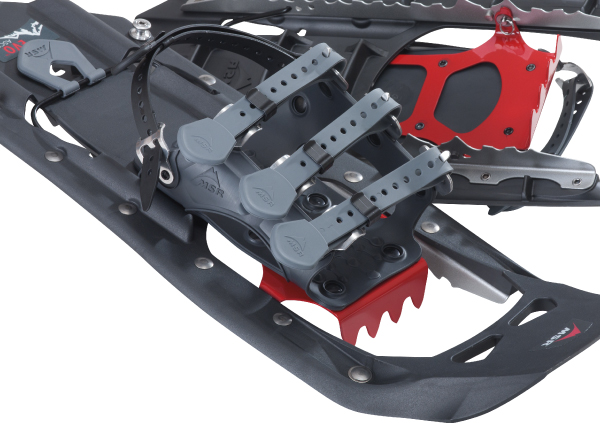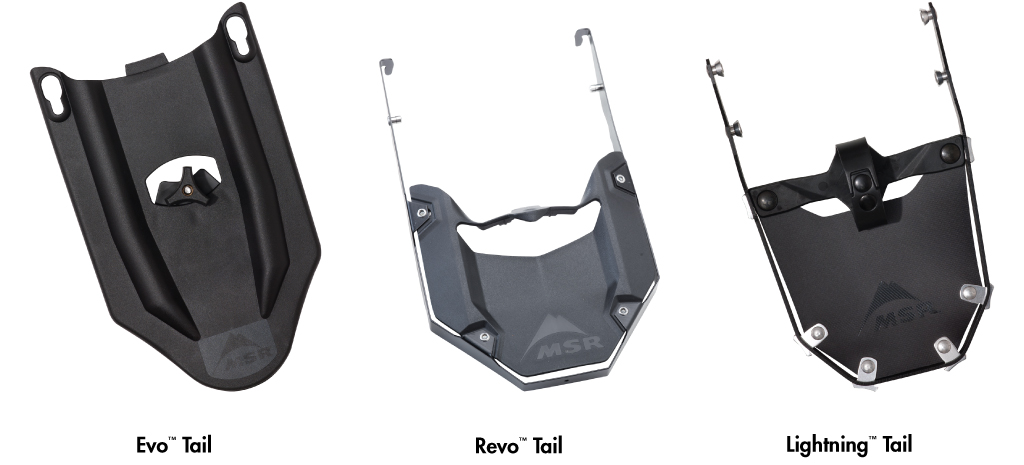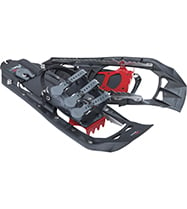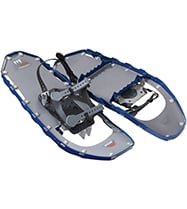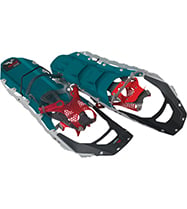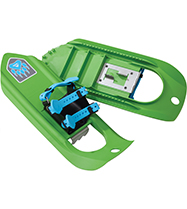The Ultimate Guide to MSR® Snowshoes
In this guide, we’ll discuss everything related to MSR snowshoes, from current offerings to navigating the snowshoes and their features, to help you find the right snowshoe for the way you enjoy snowshoeing. For some perspective, we’ll close with a brief history of snowshoes, offering a road map stretching from post-holing hunter-gatherers to how MSR revolutionized snowshoe design and performance forever.
Jump to:
- MSR Snowshoe Series
- MSR Decks and Frames
- MSR Bindings and Crampons
- MSR Snowshoe Features & Accessories
- How to Choose Snowshoes
- Snowshoe Maintenance
- Why Choose MSR Snowshoes
- Made in Market
MSR Snowshoes at A Glance
Today, our snowshoe line has designs catering to every snowshoer’s needs. Our purpose-built snowshoes are divided into three series based on the terrain you plan to traverse:
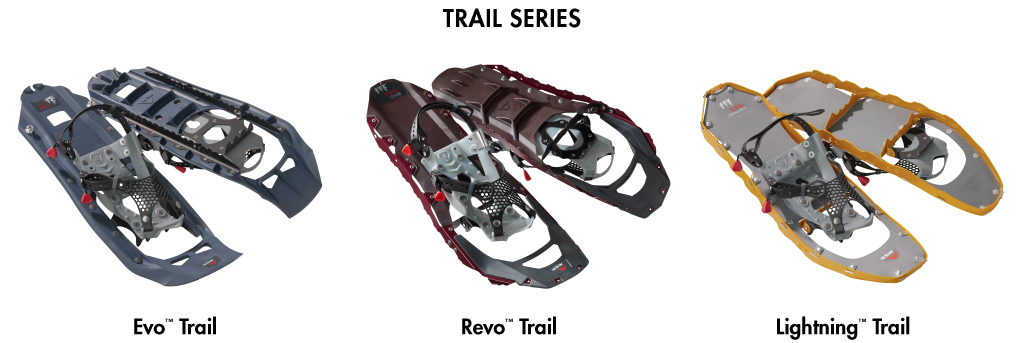
Trail Series
- Best for: Comfort, essential traction and flotation for recreational users on mellow terrain.
These snowshoes are built to deliver essential performance and comfort for day trippers spending most of their time on the flats and gently rolling hills. If you’re snowshoeing on established trails, forested areas, or maybe just need a few pairs for occasional use at your mountain hideaway, these are a great choice.

Explore Series
- Best for: Added traction, lighter weight, and all-day comfort for on- and off-trail use in a wide variety of conditions.
The Explore Series offers a great combination of the added traction needed to get deeper into the mountains in varied terrain, along with easy, intuitive and comfortable bindings for long days in the hills. They hit the sweet spot for snowshoers who dabble in a mix of casual day trips and the occasional bucket-list adventure, be that a casual summit or a mid-winter backpacking trip.

Ascent Series
- Best for: Aggressive, backcountry use in mountainous terrain.
The Ascent Series offers maximum performance with minimal weight for mountaineers, peak baggers, snowboarders and others who think of their snowshoes as a tool to get stuff done. With maximum traction and our most secure bindings, the MSR Ascent Series is the pinnacle choice for those who demand the most from their snowshoes.

Kids Series
Kids love snow, so building pint-sized snowshoes so you can take the little ones with you was an obvious move. We offer two options, from the simplicity of an introductory model for toddlers to adult-spec performance packed into pre-teen sizes.
The Tyker is our most basic option. It features a solid deck, only molded traction bars and rails for added safety (in lieu of steel) and a fixed binding with a basic crampon that allows the snowshoe to follow the foot with no dragging. These are great for introducing little ones to the idea of snowshoeing.
The Shift is a proper snowshoe, delivering big-time performance for budding adventurers. A fully hinged, backcountry-friendly binding works with shoe sizes up to 7 (USM) and a solid deck assures they’ll stand up to years of big abuse from smaller people. They include the same traction features as our most aggressive Evo snowshoes, giving you and your kids confidence and security across a range of snow conditions and terrain.
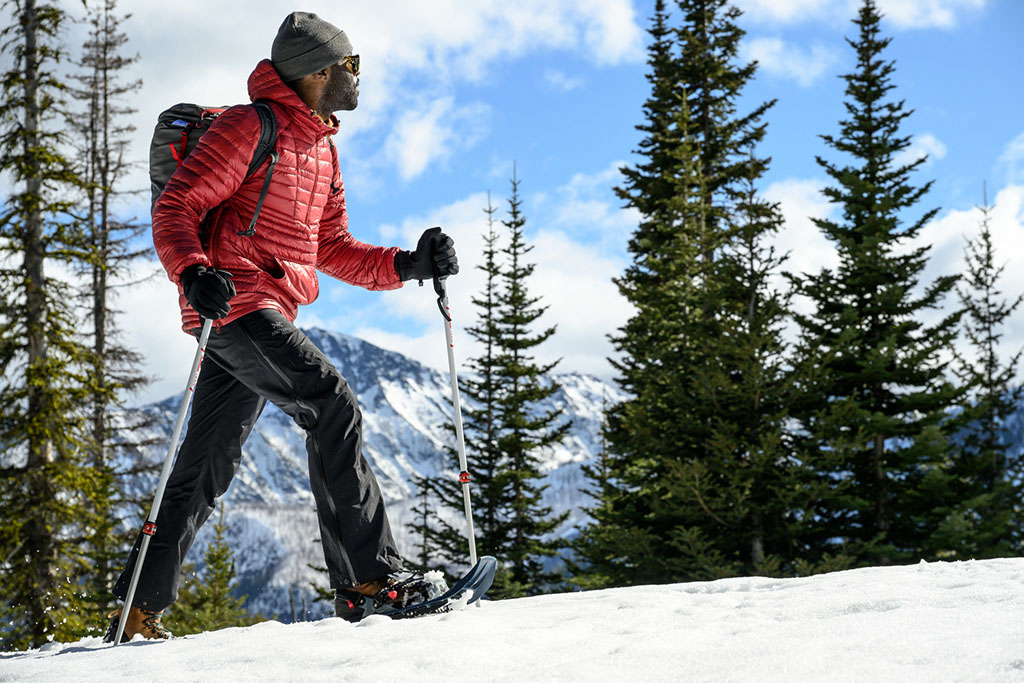
Navigating the Differences
Let’s take a look at the components of each series to understand how they differ, and which one is right for your style of snowshoeing.
DECKS/FRAMES
MSR snowshoes are unique by design. Our frames and decks are often the same thing, but that’s because we consider it all part of “Traction” and went about optimizing it in an outside-the-box kind of way.
Evo
The evolution of the game-changing Denali Snowshoe, Evo snowshoe decks are comprised of a tough and flexible, injection-molded polyethylene deck with horizontal traction bars underfoot built right into the mold.
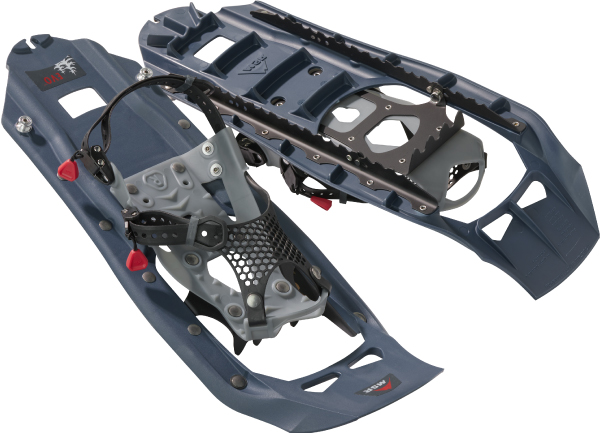
They also have two longitudinal traction bars of martensitic stainless steel for amazing side-hilling grip and lasting durability. The decks themselves have a hard edge and additional traction molded throughout the underside. These shoes also flex slightly as you walk for added comfort, and their relatively slim, ergonomic shape provides maximum flotation with a more natural stride.
Revo
The Revos are a hybrid of the injection-molded Evo and our elite 360 Traction Lightning frames. Just like you’d imagine, they offer the performance middle ground of the two, appealing to the widest range of snowshoers.
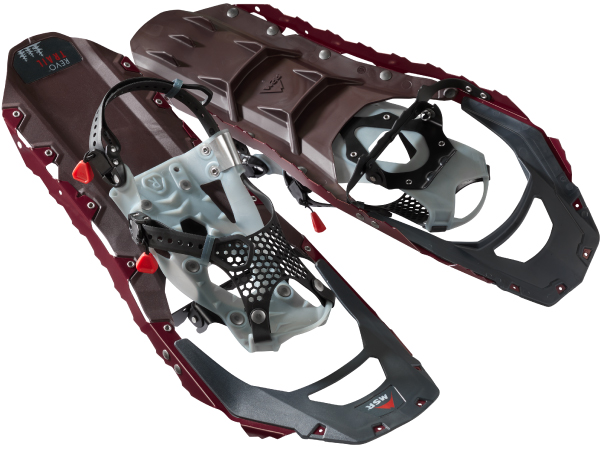
The Revo features two vertical outer frame rails, similar to the Lightning frame, but bridges them together with toe and tail pieces of injection-molded polyethylene and a single, toothed steel bar underfoot for added strength. The result is aggressive traction, with the added durability and more forgiving flex of the Evo deck.
Lightning
We like to say that Lightning snowshoes deliver more traction per ounce than any other snowshoe. There is no absolute way to quantify that, but we still like to say it because being ultralight with uncompromised traction is exactly what the Lightning frame does best.
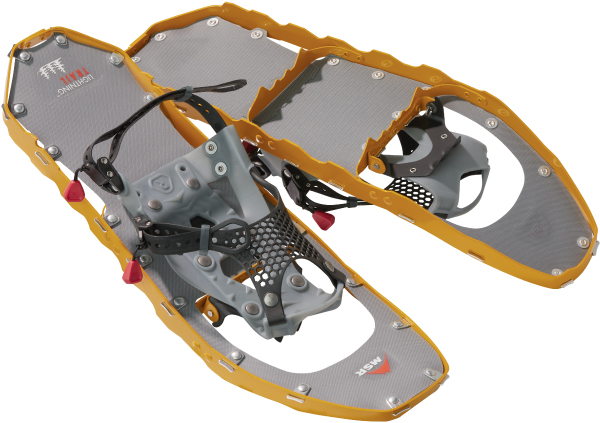
Light and strong 7000-series aluminum 360 Traction Frames deliver the ultimate, edge-to-edge traction and combine with aggressive crossbars underfoot to provide the best possible grip and strength when you need it the most. Combined with an ultralight Hypalon deck, the Lighting frame delivers the best traction with the least weight possible.
Women’s Snowshoes
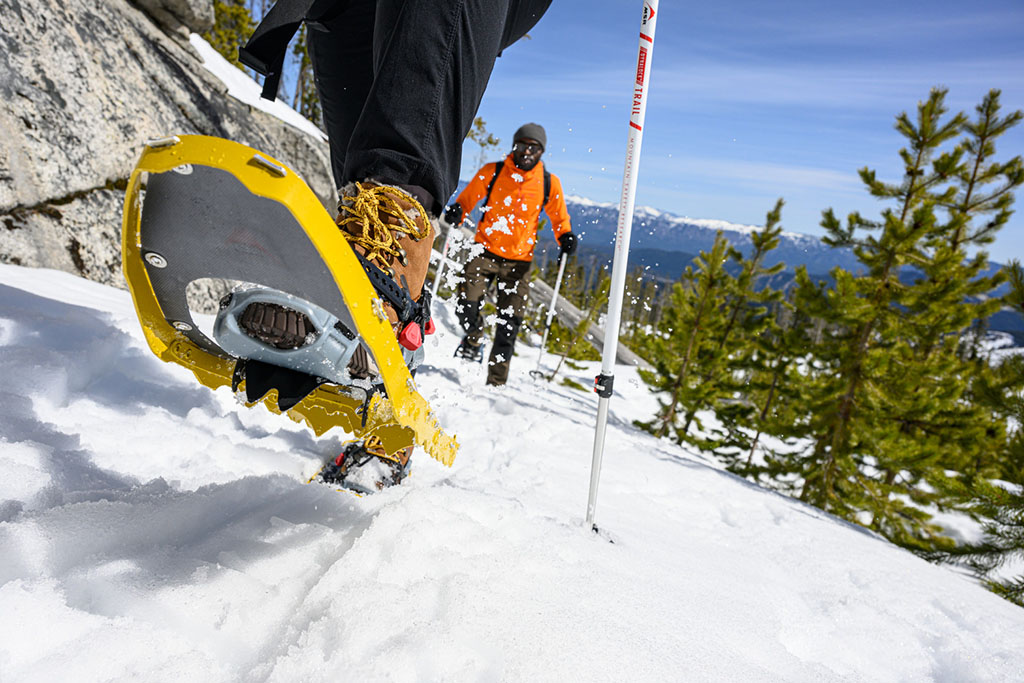
Aside from smaller binding sizes, the deck or frame is really what makes a women’s snowshoe unique. We partnered with a leading female exercise kinesiologist to design a snowshoe deck that accommodates the unique, and typically more narrow gait of female snowshoers. The result is a lower-profile snowshoe built for women that offers a more natural and efficient stride.
Bindings and Crampons
All MSR snowshoe bindings are constructed of freeze-resistant materials and are designed to compress for easy, low-profile packing. We’ve also aimed to make each intuitive and easy to use with gloved hands–essential design elements for cold weather use. Crampons and underside traction components are all made from martensitic steel for its high-carbon strength and corrosion-resistant properties. Each of our user-specific series features a binding and crampon combination tuned specifically to the needs of that intended user.
Fixed or Hinged?
You generally see two styles of bindings on snowshoes, fixed and hinged. A fixed binding is typically attached to the snowshoe via straps. This allows the snowshoe to stay closer to the position of the foot while walking, creating a more efficient stride. While this is true in purely packed conditions, these snowshoes also snap back with each step, causing them to lift and launch any snow that falls onto them. In deep snow, this can be exhausting and causes snow to be thrown into the air with each step.
Because we build our snowshoes for backcountry and trail use, we opted for a hinged binding that pivots on a steel rod, independent of the snowshoe. As you walk, the snowshoe tail drops, effortlessly shedding snow and lifting easily to glide to your next step.
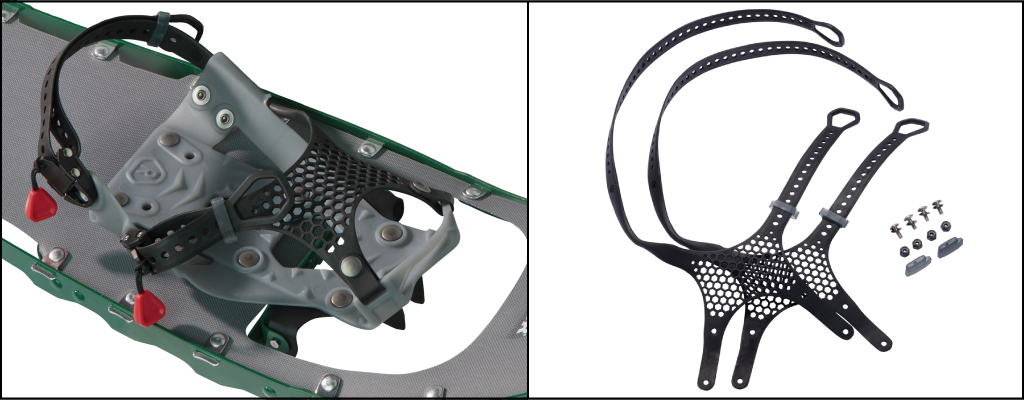
Trail Series: Paraglide™ Bindings
Our lightest bindings, Paraglide bindings were designed primarily to be easy to use and comfortable. They are best suited to those looking for all-day comfort on flat and rolling terrain. They feature a broad mesh panel across the top that comfortably hugs your foot and pull-to-operate buckle straps for easy use. They’re set atop a broad, four-tooth crampon that delivers excellent traction without being overly aggressive for a more natural stride.
Paraglide Binding Size Range:
- Men’s Model: 3 M – 13 M / 36 – 47
- Women’s Model: 5 W – 15 W / 36 – 47
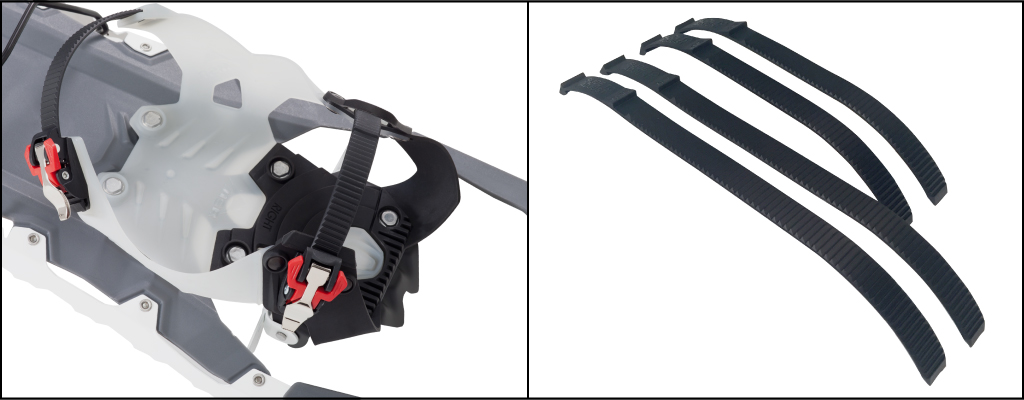
Explore Series: HyperLink™ Bindings
HyperLink bindings combine intuitive ease of use and secure comfort for all-day use. Their easy-to-use ratchet buckle system is fast and easy to get on and off and allows for quick micro-adjustments throughout the day. An EVA-padded forefoot ensures comfort and a no-slip fit. They’re perfect for more aggressive use and, as such, are set atop an aggressive, two-point crampon for added security in challenging conditions.
HyperLink Binding Size Range:
- Men’s Model: 4.5 M – 13 M / 35.5 – 48
- Women’s Model: 5.5 W – 13 W / 35.5 – 48
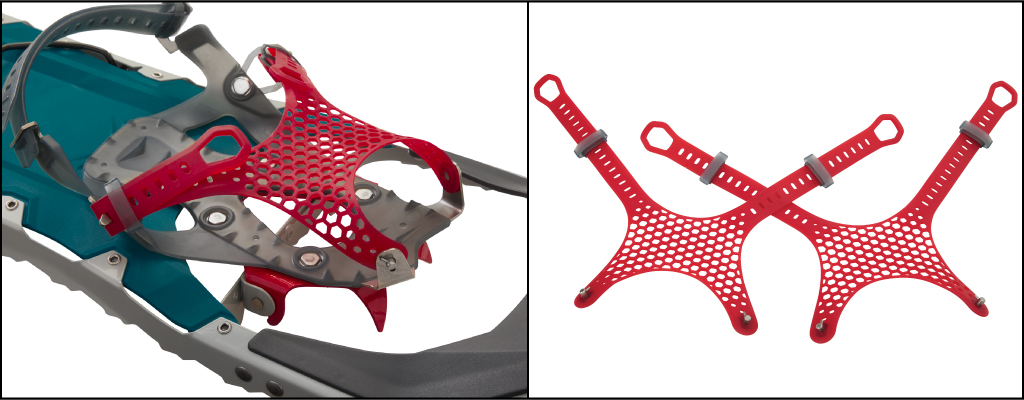 Ascent Series: Paragon™ Bindings
Ascent Series: Paragon™ Bindings
Ascent Series snowshoes (except the Evo) feature our most secure offering—the Paragon binding. The Paragon features the same, innovative stretch mesh strap as the Paraglide, holding securely without pressure points paired with our no-nonsense locking straps, leaving no guesses about security across a wide range of boots. Those straps also elevate their field maintainability, making it quick and easy to replace a damaged strap anywhere. They’re set atop an aggressive, two-point crampon that delivers the added penetration you need when dealing with sketchy conditions in the alpine.
Paragon Binding Size Range:
- Men’s Model: 6 M – 14 M / 39 – 48
- Women’s Model: 6 W – 12 W / 36 – 43
Paragon bindings come with 14-inch heel straps. If your footwear is larger than a Men’s size 14 or Women’s size 12 snowboard boot, our replacement 18-inch straps offer increased length.
An exception to the rule: The Evo Ascent Snowshoe
We’ve got a soft spot for history and for making sure great gear is accessible to as many people as possible. That’s why you’ll find the outlier of the Evo Ascent snowshoe still in our line-up. It combines a unibody Evo deck with the essential security of our legendary Tri-Fit™ bindings and Televator heels lifts, allowing you to conquer any terrain. While it doesn’t have our latest technology or our most aggressive traction, it does deliver plenty of all-terrain performance at a fantastic value.
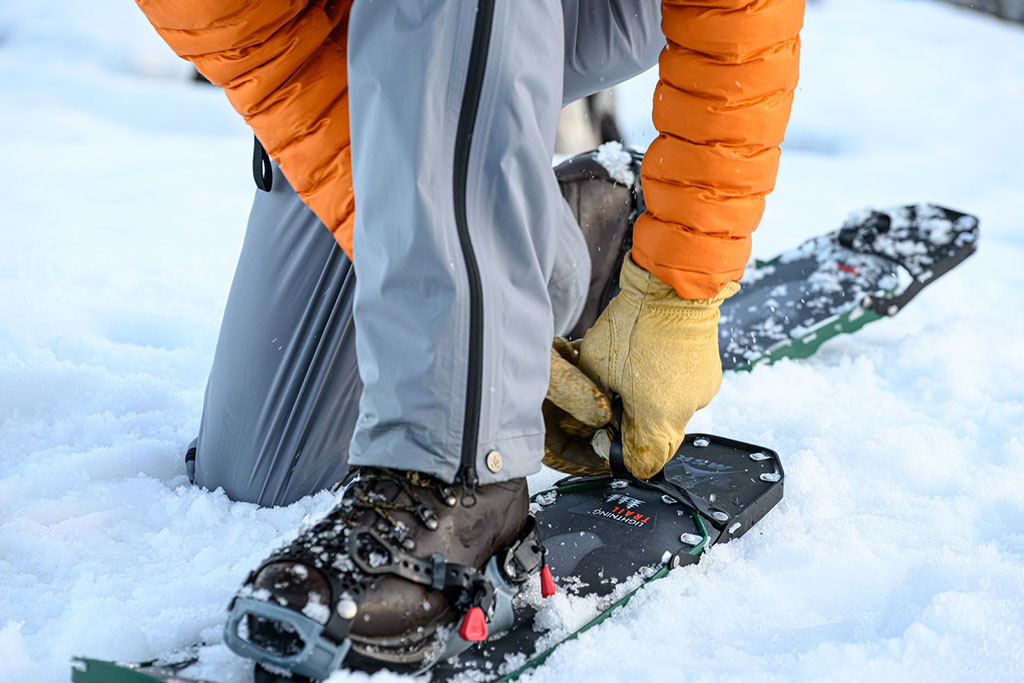
MSR Snowshoe Features & Accessories
Modular Flotation Tails
Aside from traction, flotation—the ability to not sink deeply into the snow—is the other key benefit that snowshoes provide. Your needs will vary based on how much you and your gear weigh, and the snow conditions you’ll be in. For instance, you’ll need more flotation in Colorado powder than in the dense, maritime snowpack of the Pacific Northwest.
However, we’ve removed most of the guesswork with our innovative Modular Flotation Tails. Available on all adult MSR snowshoes, they allow you to add flotation as needed. This means you can buy a snowshoe suited to your most common conditions, offering the best agility, ease of walking and lesser weight on your feet, and then add tails for more flotation in abnormally light and fluffy conditions or when carrying a heavier load. The majority of people will thus be able to use a 22-inch snowshoe for day trips and packed conditions, then simply add tails for extensive off-trail use and overnight trips.
Find a more detailed discussion and a handy sizing guide.
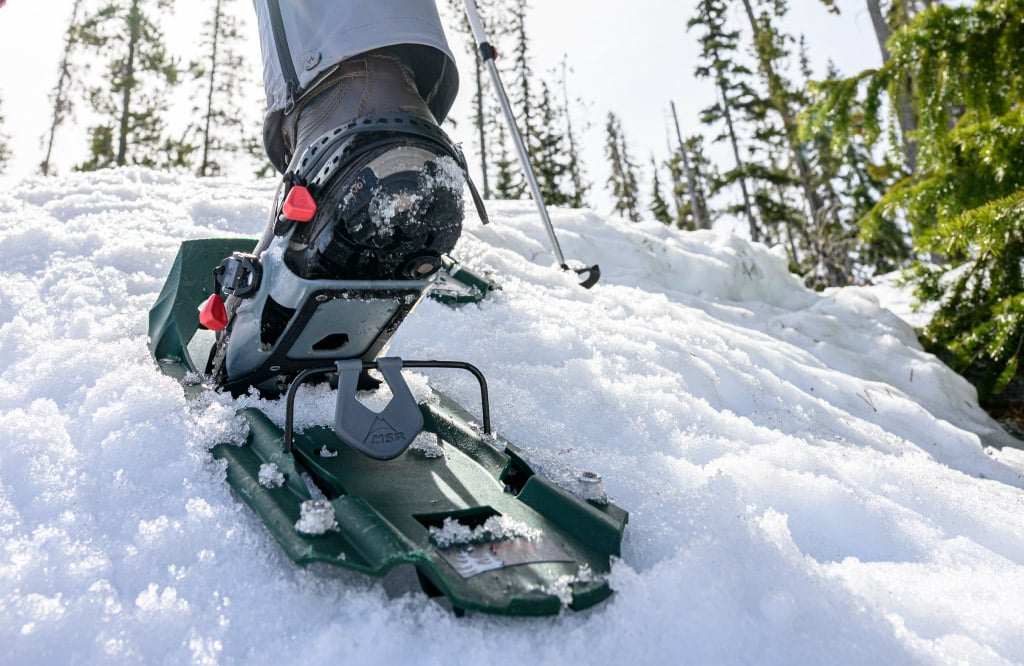
Televator™ Heel Lifts
Trudging up a steep slope can be hard. Trudging up a steep slope with Televators is a lot less hard. These handy additions to our Explore and Ascent series snowshoes neutralize the slope, allowing you to walk with a more natural, flatter foot up steep inclines. While it’s hard to quantify how much easier they can make your life, it’s easy to say that you don’t want to be without them in steep terrain. We also build our Televators with a small rise that sticks up off the deck when they are stowed. This makes them easy to deploy with a gloved hand or the handle of a trekking pole.
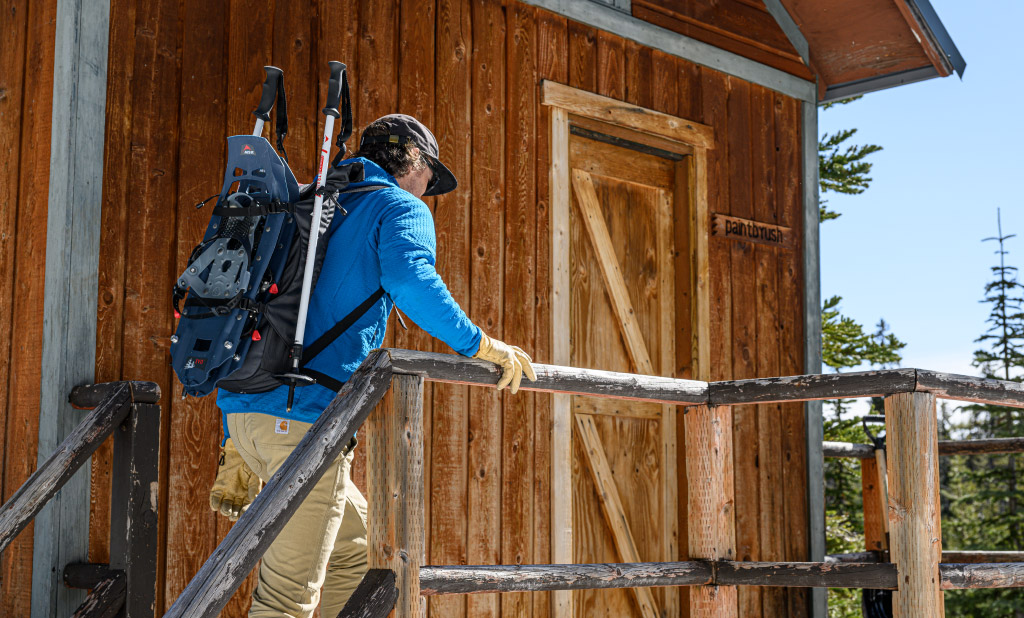
Poles
Snowshoeing poles are a mandatory addition to any snowshoeing kit for stability and safety. You’ll need adjustable poles so you can change the length to match the slope of the terrain you’re on: shorter for steep ups and longer for steep downs. You’ll also want that adjustability to be secure, freeze-resistant and glove-friendly. It’s no surprise that our DynaLock™ poles are built to be precisely that. They are segmented in the same way our snowshoes are (Trail, Explore, Ascent), so choosing the right ones should be easy now that you know your priorities. You can even grab one of these snowshoe and pole kits for one-stop shopping, adding a handy, protective storage bag that will serve you well getting to and from the trailhead.
Choosing the Right Snowshoe
We have grouped our snowshoes into three main categories: Trail, Explore and Ascent. Each series is defined by how aggressive you need your snowshoe to be based on the terrain. While all MSR snowshoes offer exceptional traction by design, the bindings, crampons and presence of Televator heel lifts really fine-tune each series for the task at hand.
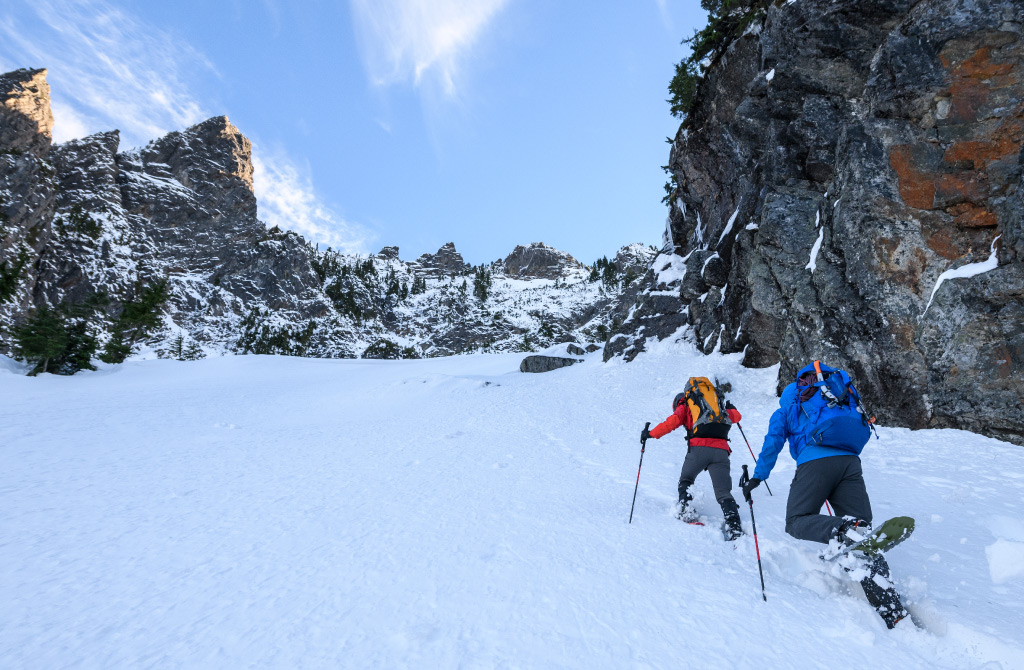
1. Know Your Terrain
Trail – Recreational Users on Flat and Rolling Terrain
Tuned for flat and rolling terrain, Trail series snowshoes feature easy, comfortable bindings and our least aggressive crampons, offering a more natural stride on established trails and occasional off-trail use below treeline.
Explore – Aggressive, All-Around Performance
Explore series snowshoes add a more aggressive crampon and Televator heel lifts to boost performance in steeper terrain and the variable snow conditions found in the backcountry. Hyperlink bindings also offer comfort and more support for longer days in the hills.
Ascent – Pinnacle Traction with Minimal Weight
Ascent series snowshoes offer even more aggressive traction than the Explore Series with a light, uber-secure binding to shave weight for steep off-trail performance. The result is ultralight reliability for peak baggers and long-distance travelers.
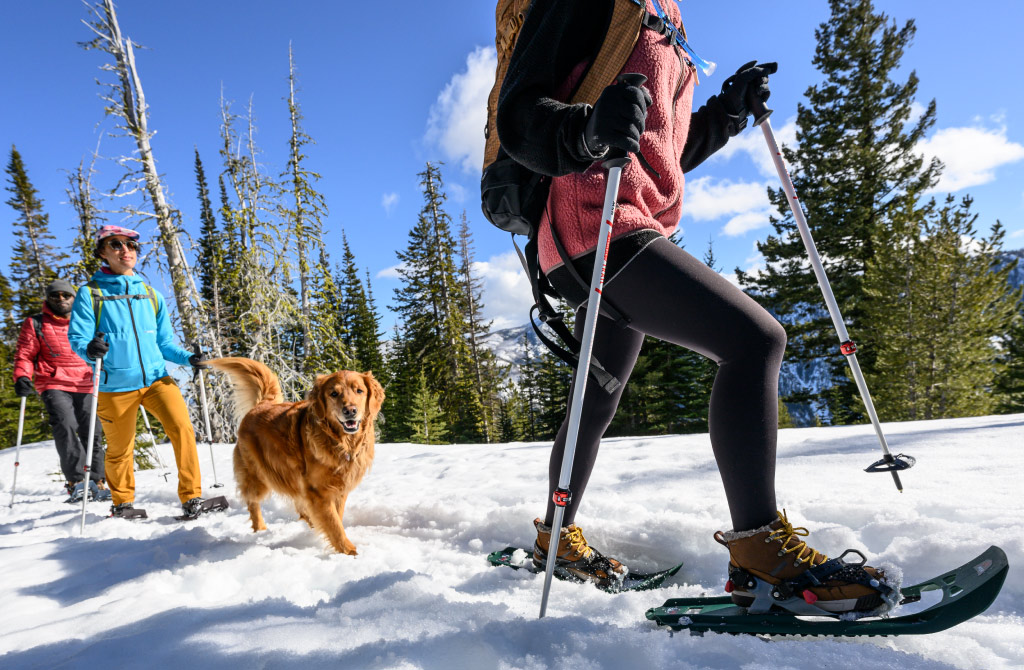
2. Choose Your Platform
Within each of the above series, you’ll find up to three styles of frame/deck to choose from.
Evo
Our most durable snowshoes are ideal for people who are hard on their gear or just good at neglecting it. These UniBody decks are made of extremely tough polypropylene, similar to what modern car bumpers are made from. If being able to abuse your gear without too much worry is your M.O., these are worthy of your attention. Evo decks also offer some torsional flex, allowing them to offer a bit more comfort over a more traditional snowshoe, as the deck will be a bit more forgiving over undulating and sloped terrain.
Lightning
The Lightning platform is for snowshoers at the other end of the spectrum—those who prioritize weight savings and want the ultimate security that a 360 Traction frame provides. Don’t get us wrong—these things are tough enough for polar explorers and expedition use—but their (replaceable) Hypalon decks are just not as tough as a solid deck. However if you value the weight and energy savings of a lighter snowshoe for longer trips and want to err on the side of added traction, go with a Lightning platform. They are also quieter on the snow than the other two options.
Revo
Still can’t decide? You’re likely a Revo kind of person. This platform combines a bit of both worlds, delivering some of the lightweight, edge-to-edge traction of the Lightning platform, mixed with the added durability of a solid deck. This is the ideal choice for people who get out pretty frequently, but keep it to mostly a day or two in conditions that range from challenging to moderate.
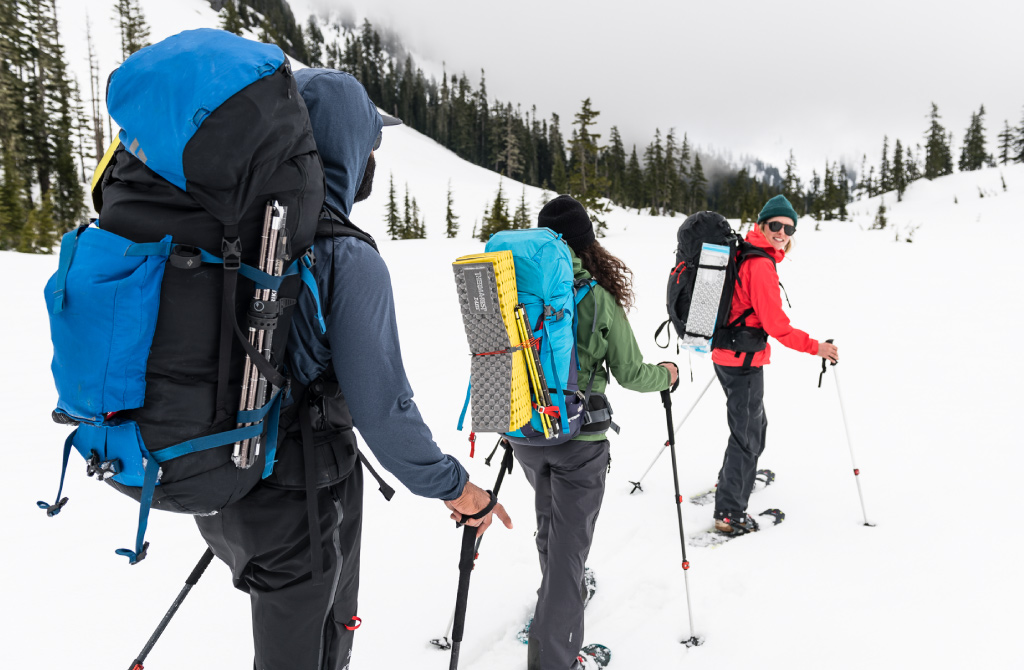
3. Choose Your Size
As previously mentioned, choosing your size in an MSR snowshoe is pretty straightforward. As the chart below shows, most people under 175 pounds should start with a 22-inch snowshoe and use Modular Flotation Tails to compensate for softer snow and/or extra gear weight as needed. If you’re considering larger sizes, remember to buy the snowshoe that will be easiest to walk in during the majority of your time on the trail. Ask any backcountry skier–deep powder is not as easy to come by as you might think, so buying a large snowshoe should really be reserved for bigger snowshoers and those carrying heavy loads. A pound on the foot is worth five on the back, as they say, so the less weight on your feet, the better.
| Your Weight | Packed Snow | Soft Snow | Soft and Deep Snow |
|---|---|---|---|
| 90-125 lbs / 41-57kg | 22 in. / 56cm |
22 in. / 56cm
|
25 in. / 64cm or 22 in. / 56cm + Tails |
| 125-175 lbs / 57-79kg | 22 in. / 56cm |
25 in. / 64cm or |
25 in. / 64cm or 22 in. / 56cm + Tails |
| 175-225 lbs / 79-120kg | 22 in. / 56cm | 25 in. / 64cm or 22 in. / 56cm + Tails |
30 in. / 76cm + Tails or 22 in. / 56cm + Tails or 25 in. / 64cm + Tails |
| 225 lbs+ / 102kg+ | 22 in. / 56cm or 25 in. / 64cm |
22 in. / 56cm + Tails or 25 in. / 64cm + Tails or 30 in. / 76cm + Tails |
30 in. / 76cm + Tails or 25 in. / 64cm + Tails |
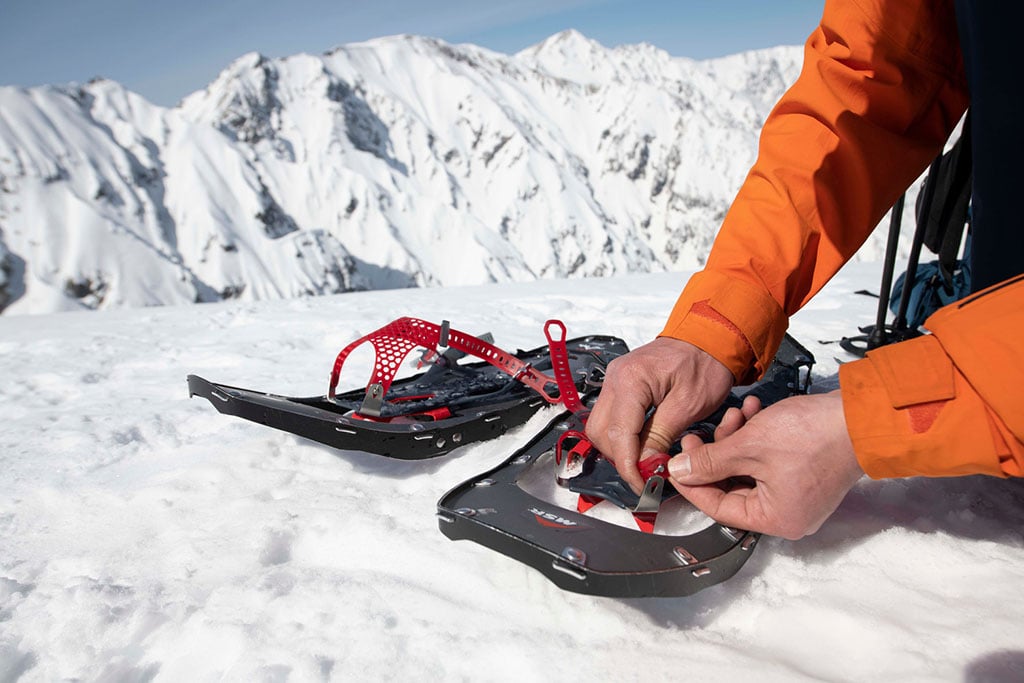
Snowshoe Maintenance
Fortunately, very little attention is needed to ensure your snowshoes provide many years of trouble-free adventure. However, there are some basic guidelines to follow:
Before Each Trip
Inspect each snowshoe for wear and damage. This includes all rivets and clevis-pin attachment points on the binding pivot rod. Check Lightning decks for tears or rips and Evo and Revo decks for any damage. Be sure your Modular Flotation Tails thread on easily and inspect crampons and binding straps for signs of wear. Old binding straps can crack and lose elasticity over time, so replace them as needed. On our Snowshoe Accessory page, you’ll find everything you need to keep your snowshoes in top condition.
After Each Trip
As with most gear, allowing your snowshoes to dry thoroughly before storage will set you up for years of enjoyment from them. Towel-dry them after use and then hang them in the open to dry. Ideally, separate your snowshoe pole sections, allowing them to dry inside and out.
Snowshoe Customer Support and Warranty
If you broke something that isn’t available on our Accessories Page or are curious if it’s covered under warranty, please contact our Warranty and Repair team for an assessment. By design, much of what we build can be repaired, keeping your trusted MSR gear out of the landfill and in the hills where it belongs.
Why MSR Snowshoes?
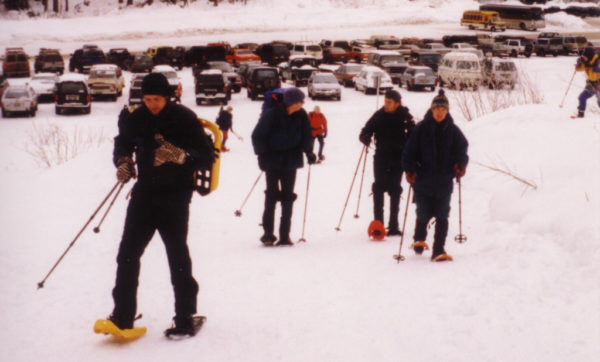
The History of MSR Snowshoes
Looking back, it’s almost no surprise that snowshoes were invented roughly 6,000 years ago. The Bronze Age was ramping up, Egypt was becoming a thing, and such ideas as sailboats, the wheel, and the earliest forms of writing were all taking shape then. At the same time, someone probably watched one too many dinners escape across deep snow somewhere in snow-covered central Asia and was inspired.
Surely, after surveying the broad and furry feet of winter game, it became apparent that the answer had something to do with surface area; the more your weight was distributed over a wider area, the less you would sink into the snow. Thus, the first snowshoes were some combination of wood and a rudimentary system of tying them to one’s feet. Eventually, the wood frame became standard, and the decking (the material within the wood frame that provides the “flotation” over snow) evolved from more wood and/or pine boughs to more durable materials like leather and gut, resulting in the classic, racquet-like snowshoes that we’re all familiar with hanging on the walls of mountain lodges everywhere.
Though this design varied greatly in shape, the basic idea remained essentially unchanged until the 1970s, when aluminum was first introduced in the form of crampons for added traction. By the 80’s, tubular aluminum frames and synthetic decking ushered in the “modern” snowshoe.
However, the introduction of tubular frames also turned out to be a weakness, creating horrible traction while traversing slopes—a common situation in snowshoeing. In packed snow and icy conditions, this was, at best, a huge hassle and at worst, highly dangerous.
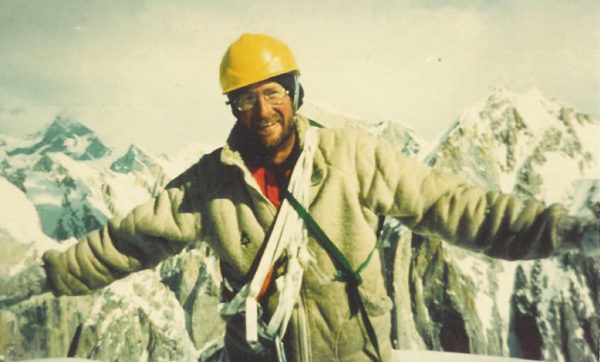
Opportunity Knocks
By the mid-’90s, renowned climber and gear designer Bill Forrest began tinkering with the idea of a solid-deck snowshoe, allowing traction to be distributed more evenly across the bottom and eliminating the problem of a round edge on the snowshoe, famously stating, “Tubes don’t cut it.” He brought a prototype to the Outdoor Retailer tradeshow in 1993 and two years later, after much refinement and bringing Forrest in-house to work with MSR, the world’s first injection-molded Denali® snowshoe was released.
MSR Delivers: Revolutionary Traction and Modular Flotation
Admittedly, people were skeptical of a plastic snowshoe at first. However, after experiencing the night-and-day performance improvements in traction and durability that they offered, the industry changed forever. The injection molded decks not only provided an “edge” to the snowshoe, eliminating the slippery nature of a tubular frame but also allowed traction to be molded into the deck itself. For good measure, serrated steel rails ran the length of the snowshoe, further enhancing grip. Combined, the traction boost was revolutionary.
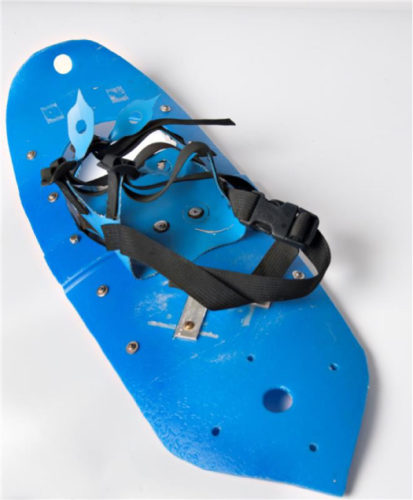
Another major innovation of the Denali snowshoe was the ability to adapt its size to match the conditions. The bigger your snowshoe, the more flotation over the snow it provides. Given snow’s fickle nature, snowshoers would often end up with a snowshoe that was either too big or too small for the conditions at hand. To address this, the Denali snowshoe introduced Modular Flotation Tails. These extensions of the snowshoe deck screwed onto the snowshoe, allowing users to adapt snowshoe performance to changing snow conditions or the added weight of larger overnight packs that demand more flotation.
In 2004, we re-set the bar again with the Lightning snowshoe design, incorporating a first-of-its-kind vertical aluminum frame. Laser-cut from aircraft-grade 7000 series aluminum, this 360 Traction™ Frame not only delivered traction along the perimeter of the entire snowshoe but also reduced weight considerably, ultimately becoming (and remaining) the ultimate choice for people who demand the most from their snowshoes in remote environments.
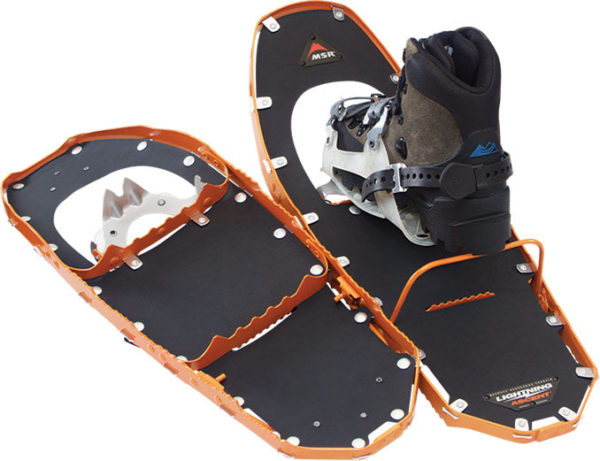
And finally, our latest deck and frame innovation came in 2014 with the release of the Revo™ snowshoe. This hybrid design combines the edge traction of the Lightning snowshoes with the unmatched durability of an injection-molded deck, delivering excellent traction and durability to meet the needs of frequent users with high expectations of their gear.
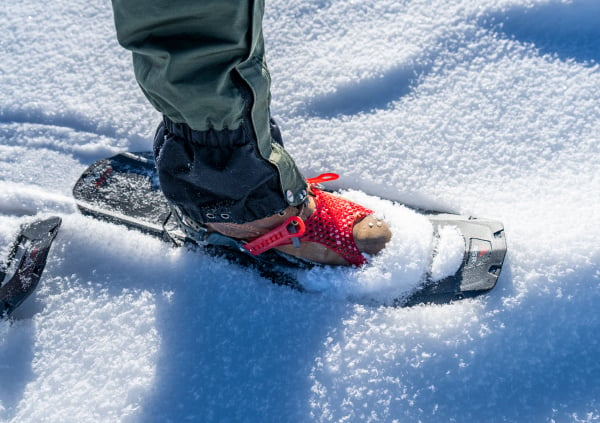
Along with superior craftsmanship, the hallmarks of unbeatable traction and modular flotation still separate MSR snowshoes from all others. Along with innovations in binding comfort and ease of use, MSR remains the gold standard for snowshoe design, performance and reliability.
Made In Market
You may have heard the phrase “Made in Market” from us before, but its role in allowing us to innovate rapidly and deliver quality products is worth mentioning again. In a nutshell, this concept of making our products in our own facilities, close to the markets they’re destined for, allows us to innovate in real-time—not over months or years as prototypes get designed, shipped, tested, broken, sent back, and repeatedly refined from off-shore.
In addition to being a much more sustainable option, thanks to incredibly decreased fuel requirements, making gear ‘in market’ means we can take an idea and test it in the mountains in a matter of days, not months. We can also spot issues with manufacturing and refine our processes in real time. This affords us the luxury of fixing things immediately, rather than being stuck with container loads of defective, off-shore products. The benefits of this manufacturing method cannot be overstated and are key to why our snowshoes lead the industry in performance, innovation and reliability.
And there you have it—the ultimate guide to MSR® snowshoes and more. Now grab some snowshoes and get outside!
Related Posts:

